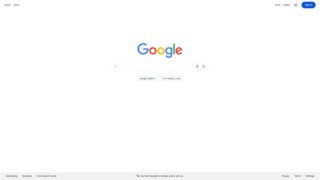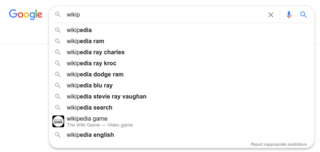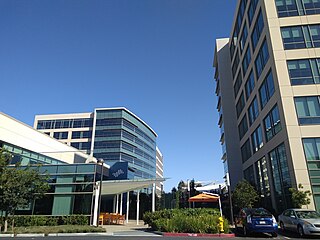Related Research Articles

Google Search is a search engine operated by Google. It allows users to search for information on the Internet by entering keywords or phrases. Google Search uses algorithms to analyze and rank websites based on their relevance to the search query. It is the most popular search engine worldwide.

robots.txt is the filename used for implementing the Robots Exclusion Protocol, a standard used by websites to indicate to visiting web crawlers and other web robots which portions of the website they are allowed to visit.
CiteSeerX is a public search engine and digital library for scientific and academic papers, primarily in the fields of computer and information science.
Search engine optimization (SEO) is the process of improving the quality and quantity of website traffic to a website or a web page from search engines. SEO targets unpaid traffic rather than direct traffic or paid traffic. Unpaid traffic may originate from different kinds of searches, including image search, video search, academic search, news search, and industry-specific vertical search engines.

The Computer Fraud and Abuse Act of 1986 (CFAA) is a United States cybersecurity bill that was enacted in 1986 as an amendment to existing computer fraud law, which had been included in the Comprehensive Crime Control Act of 1984. Prior to computer-specific criminal laws, computer crimes were prosecuted as mail and wire fraud, but the applying law was often insufficient.

Cybercrime encompasses a wide range of criminal activities that are carried out using digital devices and/or networks. These crimes involve the use of technology to commit fraud, identity theft, data breaches, computer viruses, scams, and expanded upon in other malicious acts. Cybercriminals exploit vulnerabilities in computer systems and networks to gain unauthorized access, steal sensitive information, disrupt services, and cause financial or reputational harm to individuals, organizations, and governments.
A black hat is a computer hacker who violates laws or ethical standards for nefarious purposes, such as cybercrime, cyberwarfare, or malice. These acts can range from piracy to identify theft. A Black hat is often referred to as a "cracker".
Footprinting is the technique used for gathering information about computer systems and the entities they belong to. To get this information, a hacker might use various tools and technologies. This information is very useful to a hacker who is trying to crack a whole system.

A search engine is a software system that provides hyperlinks to web pages and other relevant information on the Web in response to a user's query. The user inputs a query within a web browser or a mobile app, and the search results are often a list of hyperlinks, accompanied by textual summaries and images. Users also have the option of limiting the search to a specific type of results, such as images, videos, or news.
Chris Sullo is a security expert known as the author of Nikto Web Scanner. He is specialized in web-security and pen-testing. He was the co-founder, CFO and Treasurer of Open Security Foundation, and creator of the RVAsec security conference. He currently works as a penetration testing specialist for the IT risk firm Focal Point Data Risk.
Google Search Console is a web service by Google which allows webmasters to check indexing status, search queries, crawling errors and optimize visibility of their websites.
Johnny Long, otherwise known as "j0hnny" or "j0hnnyhax", is a computer security expert, author, and public speaker in the United States.

DuckDuckGo is an American software company that offers a number of products intended to help people protect their online privacy. The flagship product is a search engine that has been praised by privacy advocates. Subsequent products include extensions for all major web browsers and a custom DuckDuckGo web browser.

Palo Alto Networks, Inc. is an American multinational cybersecurity company with headquarters in Santa Clara, California. The core product is a platform that includes advanced firewalls and cloud-based offerings that extend those firewalls to cover other aspects of security. The company serves over 70,000 organizations in over 150 countries, including 85 of the Fortune 100. It is home to the Unit 42 threat research team and hosts the Ignite cybersecurity conference. It is a partner organization of the World Economic Forum.
Shodan is a search engine that lets users search for various types of servers connected to the internet using a variety of filters. Some have also described it as a search engine of service banners, which is metadata that the server sends back to the client. This can be information about the server software, what options the service supports, a welcome message or anything else that the client can find out before interacting with the server.

The Office of Tailored Access Operations (TAO), now Computer Network Operations, and structured as S32, is a cyber-warfare intelligence-gathering unit of the National Security Agency (NSA). It has been active since at least 1998, possibly 1997, but was not named or structured as TAO until "the last days of 2000," according to General Michael Hayden.

Cassidy Marie Wolf is an American tv host, model and beauty queen who was crowned Miss Teen USA 2013.
Blackshades is a malicious trojan horse used by hackers to control infected computers remotely. The malware targets computers using operating systems based on Microsoft Windows. According to US officials, over 500,000 computer systems have been infected worldwide with the software.

GraphQL is an open-source data query and manipulation language for APIs and a query runtime engine.

Vault 7 is a series of documents that WikiLeaks began to publish on 7 March 2017, detailing the activities and capabilities of the United States Central Intelligence Agency (CIA) to perform electronic surveillance and cyber warfare. The files, dating from 2013 to 2016, include details on the agency's software capabilities, such as the ability to compromise cars, smart TVs, web browsers including Google Chrome, Microsoft Edge, Mozilla Firefox, and Opera, the operating systems of most smartphones including Apple's iOS and Google's Android, and computer operating systems including Microsoft Windows, macOS, and Linux. A CIA internal audit identified 91 malware tools out of more than 500 tools in use in 2016 being compromised by the release. The tools were developed by the Operations Support Branch of the CIA.
References
- ↑ "Term Of The Day: Google Dorking - Business Insider". Business Insider . Archived from the original on June 19, 2020. Retrieved January 17, 2016.
- ↑ Google dork query Archived January 16, 2020, at the Wayback Machine , techtarget.com
- ↑ "nikto-versions/nikto-1.20.tar.bz2 at master · sullo/nikto-versions". GitHub. Archived from the original on August 30, 2023. Retrieved August 30, 2023.
- ↑ "googleDorks created by Johnny Long". Johnny Long. Archived from the original on December 8, 2002. Retrieved December 8, 2002.
- ↑ "Google Hacking Database (GHDB) in 2004". Johnny Long. Archived from the original on July 7, 2007. Retrieved October 5, 2004.
- ↑ Google Hacking for Penetration Testers, Volume 1. Johnny Long. 2005. ISBN 1931836361.
- ↑ "Bing Hacking Database (BHDB) v2". Bishop Fox. July 15, 2013. Archived from the original on June 8, 2019. Retrieved August 27, 2014.
- ↑ "Shodan Hacking Database (SHDB) - Part of SearchDiggity tool suite". Bishop Fox. Archived from the original on June 8, 2019. Retrieved June 21, 2013.
- ↑ "SearchDiggity - Search Engine Attack Tool Suite". Bishop Fox. July 15, 2013. Archived from the original on June 8, 2019. Retrieved August 27, 2014.
- ↑ "Google Hacking History". Bishop Fox. July 15, 2013. Archived from the original on June 3, 2019. Retrieved August 27, 2014.
- ↑ "Seven Iranians Working for Islamic Revolutionary Guard Corps-Affiliated Entities Charged for Conducting Coordinated Campaign of Cyber Attacks Against U.S. Financial Sector". UNITED STATES DEPARTMENT OF JUSTICE. Archived from the original on September 24, 2023. Retrieved March 27, 2023.
- ↑ Gallagher, Sean. "How did Iran find Cia Spies? They googled it". Ars Technica. Archived from the original on October 18, 2023. Retrieved March 27, 2023.
- ↑ Kashman, Star (2023). "GOOGLE DORKING OR LEGAL HACKING: FROM THE CIA COMPROMISE TO YOUR CAMERAS AT HOME, WE ARE NOT AS SAFE AS WE THINK". Wash. J. L. Tech. & Arts. 18 (2).
- ↑ Kashman, Star (2023). "GOOGLE DORKING OR LEGAL HACKING: FROM THE CIA COMPROMISE TO YOUR CAMERAS AT HOME, WE ARE NOT AS SAFE AS WE THINK". Washington Journal of Law, Technology & Arts. 18 (2): 1. Archived from the original on October 23, 2023. Retrieved March 27, 2023.